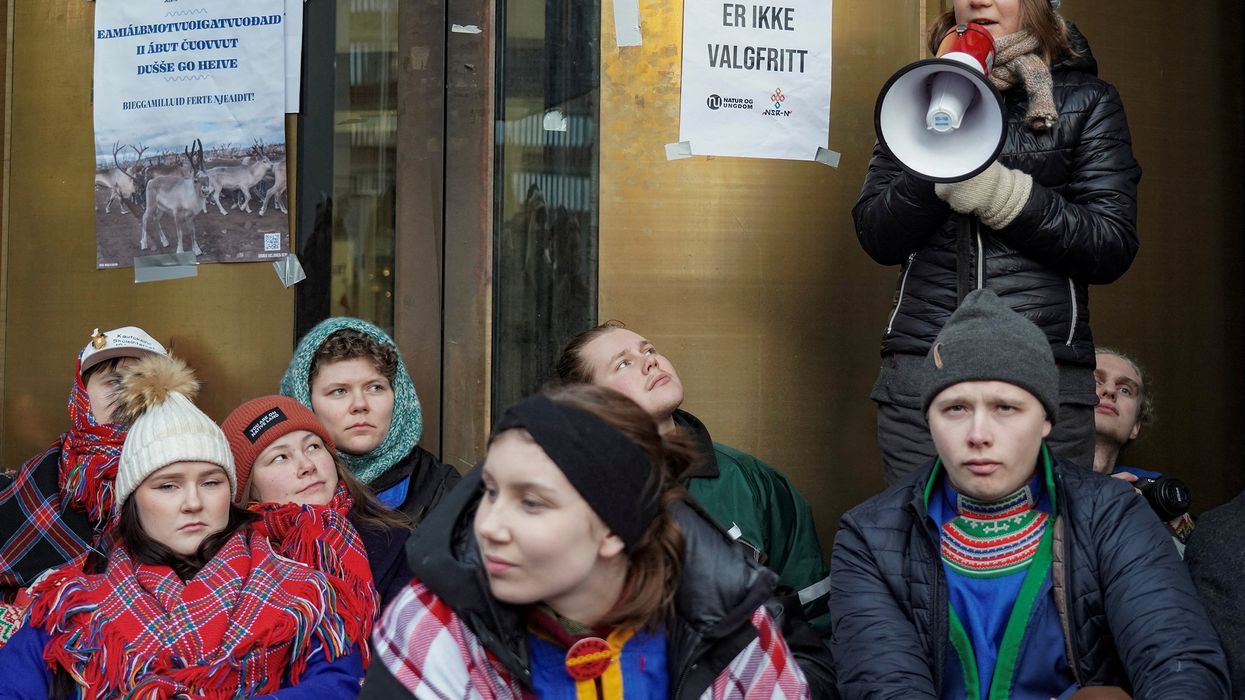(CNN) — It may seem strange to see Greta Thunberg protesting against wind turbines, but this week the Swedish climate activist has joined Indigenous and environmental groups in Norway to do just that.
Dozens of protestors, including Thunberg, have blocked access to Norwegian government buildings in Oslo to protest against two windfarms built on Sámi reindeer grazing grounds.
On Wednesday morning, 10 people including Thunberg were removed by police from the entrance of the ministry of finance, according to a spokesperson for the Oslo police district.
The Sámi people, the only recognized Indigenous group within the European Union, say their centuries-old tradition of reindeer herding is jeopardized by the windfarms in the Fosen region in Central Norway. Among the largest onshore windfarms in Europe, they are made up of 151 wind turbines that stretch 285 feet high.
"The constructions are stealing the reindeer's grazing land," Maja Kristine Jåma, a reindeer herder and Sámi politician, told CNN. The reindeer are also affected by the infrastructure around the turbines, including roads, she said. "It disturbs them a lot."
Jåma and others are calling for the turbines to be torn down and the reindeer grazing lands restored.
"Indigenous rights, human rights, must go hand-in-hand with climate protection and climate action. That can't happen at the expense of some people," Thunberg told Reuters on Monday.
The fight over the wind turbines has been long running.
In October 2021, the Sámi people secured a legal victory. Norway's Supreme Court ruled that the wind farm permits were invalid because the turbines violated the protected cultural rights of Sámi people by infringing on reindeer grazing lands.
But nearly a year and half on, the turbines are still operating.
"So far, the government has not even acknowledged the Supreme Court's ruling on the violation of human rights or offered an apology to the Reindeer Sámi," Eirik Larsen, Political Advisor to the Sámi Parliament in Norway, told CNN.
The Norwegian government said it is assessing how to secure the Sámi's rights in Fosen. "The Supreme Court has considered that the permits that have been granted are invalid, but it does not follow from the judgment that the wind turbines must be taken down," Elisabeth Sæther, State Secretary in the Norwegian Ministry of Petroleum, told CNN.
Sæther added that the government has been consulting with reindeer herders and the Sámi Parliament to find solutions "that make it possible for reindeer herding and the wind turbines to operate side by side."
What's happening in Norway is part of a growing conundrum when it comes to the green transition: How to implement climate policies without riding roughshod over Indigenous rights and the environment.
Wind energy is an important plank in Norway's green energy transition. The country's electricity generation is already almost completely renewable. In 2020, more than 90 percent of its electricity was generated using hydropower and wind, which has increased 10-fold in the last decade, accounted for 6.5 percent.
Norway, which remains a major oil and gas producer, has pledged to reduce its levels of planet heating pollution to 55 percent below 1990 levels by 2030.
"But you cannot have a green shift that violates human rights or Indigenous rights," said Jåma. "These constructions threaten our way of living and our way of engaging in our culture as reindeer herders."
Jåma calls what's happening "green colonization," a term the Norwegian government told CNN was "misleading and incorrect."
Steve Trent, CEO and Founder of the Environmental Justice Foundation, told CNN: "The Sámi did not cause the climate crisis, and their traditional ways of life - which they have practiced for millennia - should not be jeopardized by efforts to resolve it."
"Our efforts to roll back global heating must be equitable and fair," he added.
The Sámi people, whose traditional lands — Sapmi — span northern parts of Sweden, Norway, Finland and Russia, already live on the frontline of the climate crisis.
The Arctic is warming as much as four times faster than the rest of the world and the temperature changes are making it harder for reindeer to feed, as increased rainfall means layers of ice freeze over their food.
"Indigenous Peoples are asked to give up their lands for the wind industry, mining, and other purposes to save the world from a crisis mainly created by others," Larsen said.
The-CNN-Wire
™ & © 2023 Cable News Network, Inc., a Warner Bros. Discovery Company. All rights reserved.
- Greta Thunberg and 600 Youth File Lawsuit Against Swedish Government for Climate Change Inaction ›
- Greta Thunberg Forcefully Removed From Protest by German Police ›

















































